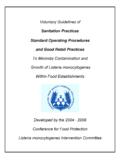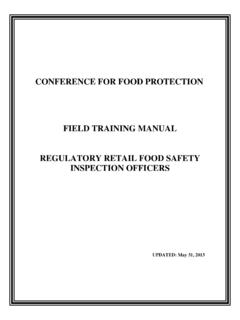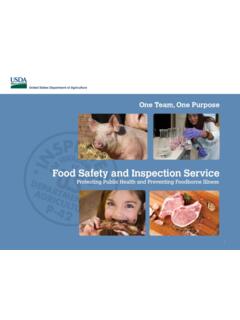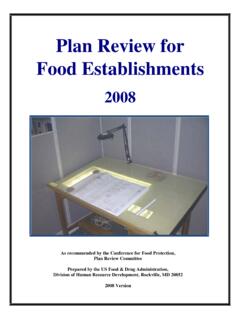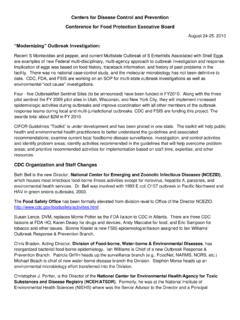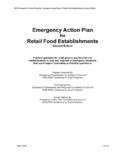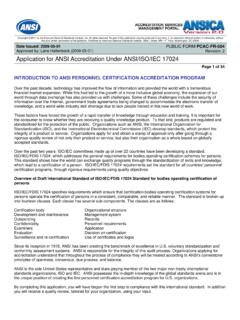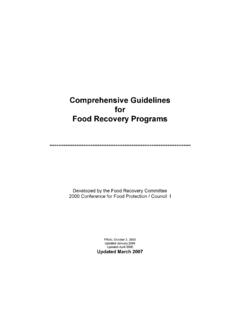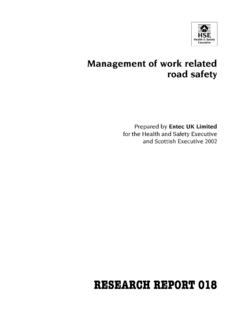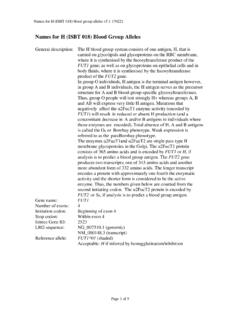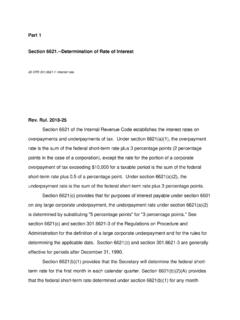Transcription of TIME-TEMPERATURE TABLES FOR COOKING READY-TO …
1 TIME-TEMPERATURE TABLES FOR COOKING READY-TO -EAT. POULTRY PRODUCTS. The 1999 FSIS final rule, Performance Standards for the Production of Certain Meat and Poultry Products, requires a log10 relative reduction ( log10 lethality) of Salmonella for cooked beef, roast beef and corned beef (9 ). Appendix A in the compliance guidelines for this 1999 final rule, included two TIME-TEMPERATURE (TT). columns in a table for roast beef, cooked beef and corned beef products. One column was for log10 and the other column was for a log10 relative reduction of Salmonella (Attachment 1). The TT column for a log10 relative reduction in whole beef products was included as a guide for those establishments that wanted to process these beef products to exceed the required minimum logs for an additional measure of safety. The 1999 final rule also established a performance standard for poultry that requires a log10 lethality of Salmonella in RTE poultry (9 CFR ).
2 The compliance guidelines for this rule provided one temperature each for COOKING uncured poultry (160 F) and for cured poultry (155 F) to meet the performance standard. FSIS did not provide a time - temperature table for COOKING poultry at temperatures lower than 160 F because there was inadequate research information at that time . FSIS has been made aware that some users of the TT TABLES in Appendix A are under the impression that the TT column for a log10 reduction of Salmonella for cooked beef can also be used for COOKING poultry to achieve a log reduction in poultry and meet the performance standard. As a result, some establishments use the log10 meat TT. column for COOKING poultry. Establishments that have been applying the log10 column in the meat TABLES for COOKING poultry could be undercooking their products. There is relatively greater risk of undercooking if the initial level of Salmonella in their raw product is high.
3 Furthermore, studies have shown that there is a difference in bacterial resistance due to the type of product species. This could result in Salmonella positive products and foodborne illness. Currently, there is no information as to how many establishments use the log meat TT TABLES for COOKING poultry, nor is there information on actual instances of poultry products cooked at a time and temperature combination from the these TABLES that were inadequately cooked, resulting in Salmonella positive products and foodborne illness. The 1999 final rule provides for the use of an alternative' lethality to meet the performance standard ( log10 required lethality) for Salmonella in poultry products. The alternative lethality achieves the same probability that no viable Salmonella organisms remain in any finished product as that achieved with lethality for the worst case default FSIS assumption.
4 If an establishment is using a TT combination not included in the Compliance Guidelines for COOKING poultry, then it can either: 1) validate that the TT combination it is using for its COOKING process to establish that it achieves a log lethality of Salmonella, or 2) demonstrate in some fashion that an equivalent probability of no remaining viable Salmonella organisms in the finished product is obtained. For the first case, validation can be done by conducting a challenge study or using studies or documentation showing that the establishment's lethality process is adequate to achieve log10 lethality in its cooked poultry product. For the second case, for example, an establishment can provide documentation showing that its initial Salmonella levels in the raw material are low enough to assure that its lethality process eliminates the pathogen in any contiguous 100 grams of finished product, to the extent of providing the same probability that there are no viable Salmonella as that when a log10 lethality is achieved, assuming the FSIS default worst case level.
5 In both these cases, the validation and documentation must also demonstrate the reduction of other pathogens and their toxins or toxic metabolites necessary to prevent adulteration of the finished product. The establishment should ensure that conditions of processing such as additives ( , salt) used in the product, and humidity applied during the lethality treatment, are reflected in the studies that determine lethalities and subsequent values of time and temperature parameters. A detailed explanation of validation or demonstration procedures for an alternative lethality can be found in Lethality and Stabilization Performance Standards for Certain Meat and Poultry Products: Technical Paper pp. 15 . 17 found on the FSIS website: In order to provide guidance to establishments on the processing of poultry products, FSIS requested ARS to conduct a study to determine the times and temperatures of COOKING chicken and turkey to achieve a log10 relative reduction of Salmonella.
6 This study provided FSIS with new time /temperature TABLES for COOKING poultry. The proposed performance standards for processed RTE meat and poultry products (issued 2/7/2001 in FR) included these new TT TABLES for COOKING chicken and turkey of different fat contents to achieve a log10 relative reduction of Salmonella (Attachment 2). The proposed rule with the new poultry TABLES is posted on the FSIS website: . The published study title and authors are as follows: TITLE: Modeling non-linear survival curves to calculate thermal inactivation of Salmonella in poultry of different fat levels AUTHORS: V. K. Juneja, B. S. Eblen, H. M. Marks JOURNAL: International Journal of Food Microbiology 70 (2001) 37-51. The holding times for COOKING poultry at specific temperatures in these new TABLES for a log10 relative reduction of Salmonella in poultry are longer than those listed in the column for the log10 relative reduction of Salmonella in roast beef, cooked beef and corned beef.
7 The log10 meat TT table achieves lower lethality compared to the new TT TABLES for poultry. For example, the new TABLES specify that for a chicken product with 7% fat, 29 minutes at 140 F is needed to obtain a 7-log10 lethality, whereas for this temperature, the TT TABLES for cooked beef specify 12 minutes is needed. The model in the above referred paper predicts that approximate lethality is obtained when poultry with 7% fat is cooked for 12 minutes; thus in this case the expected obtained lethality is about 4 log10 less than that required. For higher fat levels the difference would be greater. For COOKING of poultry products other than chicken and turkey, use of the longer time at a certain temperature from the TABLES is recommended. Application of humidity such as those found in Appendix A should also be considered. 2. Establishments have been utilizing the COOKING temperatures for poultry outlined in Appendix A for a number of years.
8 However, the guidelines reflect new data on the temperatures needed to control Salmonella in poultry. The Agency is not rescinding the guidance for poultry in Appendix A, but an establishment needs to take this new data regarding increased time at a specific temperature to achieve a given level of reduction of Salmonella into consideration. An establishment can continue to utilize Appendix A. within its process and should be conducting on-going verification to confirm that the process is being effectively controlled. The Agency will continue to collect verification samples for RTE products. If an establishment is using Appendix A, and the Agency collects an RTE sample that is positive for Salmonella, the establishment would be required under (b) to support its decision within its hazard analysis. Consequently, it is advisable that establishments using Appendix A verify its process on an on-going basis to ensure that Salmonella is being controlled effectively.
9 To summarize, in the absence of additional scientific rationale specific to the process within an establishment, in order to meet the objective of the performance standard, , achieve a log10 lethality of Salmonella in cooked poultry products, establishments could: 1) use the TT combinations in the new chicken and turkey TABLES (Attachment 2), and also found in the compliance guidelines for the proposed performance standards for processed meat and poultry products, with the application of adequate humidity, if deemed appropriate by the establishment; or 2) use any TT combinations provided they are validated for a process to achieve a log10 lethality of Salmonella; or 3) apply a different (lower) minimum lethality, provided the same probability of no viable Salmonella in poultry as the probability obtained when there is a log10 lethality assuming FSIS's default worst-case levels, while also assuring that other pathogens and their toxins or toxic metabolites are destroyed, so as not to adulterate the finished product.
10 This provision can be used when Salmonella is not uniformly distributed in the product, or can be met by a plant when that plant establishes its worst-case level of Salmonella to be less than the FSIS assumed worst-case level. 3. ATTACHMENT 1 Cooked beef and roast beef, including sectioned and formed roasts, chunked and formed roasts, and cooked corned beef can be prepared using one of the following time and temperature combinations to meet either a or 7-log10 reduction of Salmonella. The stated temperature is the minimum that must be achieved and maintained in all parts of each piece of meat for a least the stated time : Minimum Internal Minimum processing time in Temperature minutes or seconds after minimum temperature is reached Degrees Degrees 7-log10. Fahrenheit Centigrade Lethality Lethality 130 112 min. 121 min. 131 89 min. 97 min. 132 71 min. 77 min. 133 56 min. 62 min.
